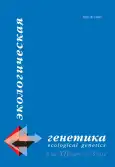The History of Manayunkia [Polychaeta: Sedentaria: Sabellidae] propagation in North Eastern Asia
- Authors: Pudovkina T.A.1, Sitnikova T.Y.1, Matveyev A.N.2, Shcherbakov D.Y.1
-
Affiliations:
- Limnological Institute, Siberian Division, Russian Academy of Sciences
- Irkutsk State University
- Issue: Vol 12, No 3 (2014)
- Pages: 32-42
- Section: Articles
- URL: https://journals.rcsi.science/ecolgenet/article/view/2423
- DOI: https://doi.org/10.17816/ecogen12332-42
- ID: 2423
Cite item
Full Text
Abstract
Keywords
Full Text
##article.viewOnOriginalSite##About the authors
Tatyana Anatolyevna Pudovkina
Limnological Institute, Siberian Division, Russian Academy of Sciences
Email: tap77@rambler.ru
engineer. Laboratory of Molecular Systematics
Tatyana Yakovlevna Sitnikova
Limnological Institute, Siberian Division, Russian Academy of Sciencesdr., senior researcher. Laboratory of Biology of aquatic invertebrates
Arkadiy Nikolayevich Matveyev
Irkutsk State Universitydr., professor. Head of Department of Biology and Soil Sciences
Dmitriy Yuryevich Shcherbakov
Limnological Institute, Siberian Division, Russian Academy of Sciences
Email: sherb@lin.irk.ru
Head of Laboratory of Molecular Systematics
References
- Верещагин Г. Ю. (1940) Происхождение и история Байкала, его фауны и флоры. Труды Байк. лимн. ст. АН СССР. Т. X.
- Гоманенко Г. В., Камалтынов Р. М., Кузьменкова Ж. В. (2005) Популяционная структура байкальского бокоплава Gmelinoides fasciatus (Stebbing). Генетика. Т. 41: С. 1108-1114.
- Клишко О. К. (1994) Фенотипические различия полихет Manayunkia baicalensis Nusb. из водоемов бассейнов рек Лены и Амура. Докл. АН СССР. Сер. Общ. биология. Т. 335: С. 116-117.
- Клишко О. К. (1996) Полихета Manayunkia baicalensis Nussb. в водоемах бассейнов рек Лена и Амур. Известия РАН. № 1: С. 101-105.
- Кожов М. М. (1962) Биология озера Байкал. М.: Наука. 315 с.
- Кожов М. М. (1972) Очерки по Байкаловедению. Иркутск: Вост.-Сиб. книжн. изд-во. 254 с.
- Ламакин В. В. (1952) Ушканьи острова и проблема происхождения Байкала. М.: Географгиз. 199 с.
- Мац В. Д., Уфимцев Г. Ф., Мандельбаум М. М. и др. (2001) Кайнозой Байкальской рифтовой впадины: Строение и геологическая история. Новосибирск: Изд-во СО РАН., филиал «Гео». 252 с.
- Мац В. Д., Фуджии, Ш., Машико, К. и др. (2002) К палеогидрологии Байкала в связи с неотектоникой. Геология и геофизика. Т. 43 (2): С. 142-154.
- Остерман Л. А. (1981) Методы исследования белков и нуклеиновых кислот. Электрофорез и ультрацентрифугирование. М.: Наука. 288 с.
- Перетолчина Т. Е., Ситникова Т. Я., Щербаков Д. Ю. (2006) Исследование популяционного генетического полиморфизма эндемичного байкальского вида Baicalia carinata (Mollusca, Caenogastropoda). Ruthenica. Т. 16(1-2): С. 105-111.
- Ситникова Т. Я. (2001) Многощетинковые черви (ANNELIDA: POLYCHAETA). Аннотированный список фауны озера Байкал и его водосборного бассейна. Под ред. О. А. Тимошкина. Т. 1 книга 1: С. 428-431.
- Ситникова Т. Я., Щербаков Д. Ю., Огарков О. Б., Щербакова Т. А. (1995) О родственных взаимоотношениях байкальских полихет. Вторая Верещагинская. Байк. конференция. Иркутск. С. 177.
- Ситникова Т. Я., Щербаков Д. Ю., Харченко В. В. (1997) О таксономическом статусе полихет рода Manayunkia (Sabellidae, Fabricinae) из Байкала. Зоол. журнал. Т. 76: С. 16-27.
- Сластников Г. С. (1940) К нахождению многощетинкового червя Manayunkia в бассейне реки Гыда. Природа. № 7: С. 76-77.
- Тахтеев В. В., Снимщикова Л. Н., Окунева Г. Л. и др. (1993) Характеристика донного населения глубинной зоны Байкала. Экология. № 6: С. 60-67.
- Томилов А. А. (1954) Материалы по гидробиологии глубоководных озер Олекмо-Витимской горной страны. Тр. Иркутск. ун-та. Сер. биол. Т. 11: С. 1-86.
- Bukin Ju. S., Pudovkina T. A., Sherbakov D. Ju., Sitnikova T. Ya. (2007) Genetic Flows in a Structured One-Dimensional Population: Simulation and Real Data on Baikalian Polychaetes M. Godlewskii. In Silico Biology. V. 7: P. 277-284.
- Canales-Aguirre C. B., Rozbaczylo N., Hernández C. E. (2011) Genetic identification of benthic polychaetes in a biodiversity hotspot in the southeast Pacific. Revista de Biologia Marina y Oceanografia. V. 46: P. 89-94.
- Doyle J. J., Dickson E. E. (1987) Preservation of plant samples for DNA restriction endonuclease analysis. Taxon. V. 36: P. 715-722.
- Folmer O., Black M., Hoeh W. et al. (1994) DNA primers for amplification of mitochondrial cytochrome C subunit I from diverse metazoan invertebrates. Mol. Mar. Biol. Biotech. V. 3: P. 294-299.
- Kaygorodova I. A., Sherbakov D. Yu., Martin P. (2007) Molecular phylogeny of Baikalian Lumbriculidae (Oligochaeta): evidence for recent explosive speciation. Comparative Cytogenetics. V. 1: P. 71-84.
- Maniatis T., Fritsch E. F., Sambrook J. (1982) Molecular cloning: A laboratory manual. Gold Spring Harbor Laboratory Press. New York. 545 p.
- Nusbaum J. (1901) Dybowcella baicalensis nov. gen. Ein in Sueswasser lebendes Polychaet. Biol. Ctrbl., V. 21: P. 6-19.
- Posada D. (2008) jModelTest: phylogenetic model averaging. Mol. Biol. Evol. V. 25: P. 1253-1256.
- Rambaut A. (2006-2012) Tree figure drawing tool. Version 1.4.0. Institute of evolutionary biology. University of Edinburgh. http://tree.bio.ed.ac.uk.
- R Core Team (2013) R: A language and environment for statistical computing. R Foundation for Statistical Computing. Vienna, Austria. http://www.R-project.org.
- Ronquist F., Teslenko M., van der Mark P., et al. (2012) MrBayes 3.2: Efficient Bayesian phylogenetic inference and model choice across a large model space. Syst. Biol. V. 61: P. 539-542.
- Tajima F. (1989) Statistical method for testing the neutral mutation hypothesis by DNA polymorphism. Genetics. V. 123: P. 585-595.
- Tamura K., Peterson D., Peterson N. et al. (2011) MEGA5: Molecular Evolutionary Genetics Analysis using Maximum Likelihood, Evolutionary Distance, and Maximum Parsimony Methods. Mol. Biol. Evol. V. 28: P. 2731-2739.
- Wilke T., Schultheib R., Albrecht C. (2009) As time goes by: A simple fool's guide to molecular clock approaches in invertebrates. Amer. Malac. Bull. V. 27: P. 25-45.
- Xie W., Lewis P. O., Fan Y. et al. (2011) Improving marginal likelihood estimation for Bayesian phylogenetic model selection. Syst. Biol. V. 60: P. 150-160.
- Zenkewitsch L. (1935) Über d. Manayunkia (M. polaris) an dem Murman - Küsten. Zool. Anz. B., 199, 718.
Supplementary files






